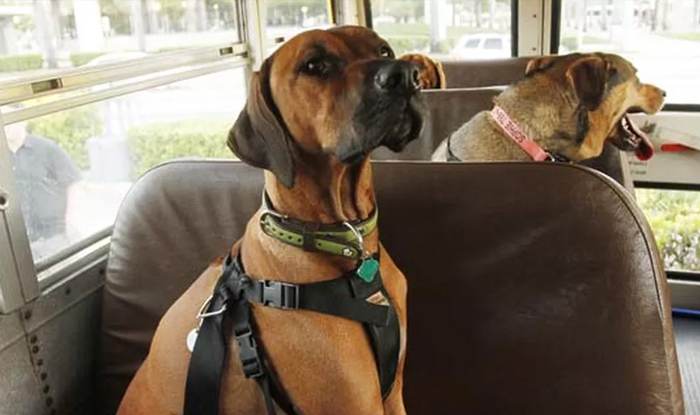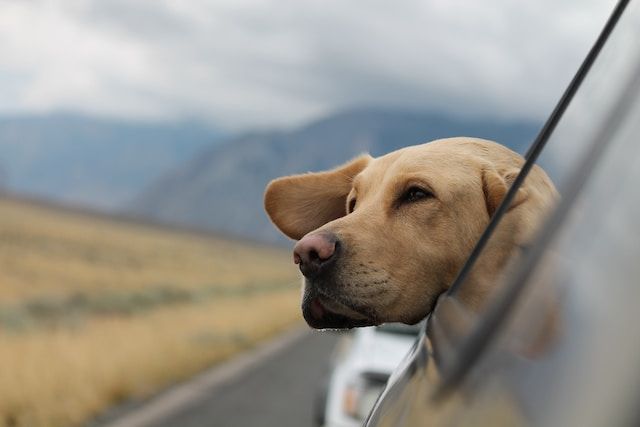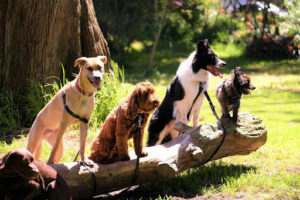Did you know that traveling with dogs can reduce stress levels for both humans and our four-legged companions?
A study by The American Heart Association showed that being in the company of our furry buddies reduces stress by releasing oxytocin, the “feel-good” hormone, in both humans and dogs.
Traveling with dogs can also provide excellent opportunities for socialization, according to the American Kennel Club. Exploring varied environments, meeting new people, and interacting with other dogs can help our furry pals develop better social skills and boost their overall confidence. Plus, it’s a fantastic way for us humans to meet fellow dog enthusiasts and exchange those “aww”-inducing stories about our four-legged adventurers.
In this article, we’ll discuss various modes of traveling with dogs, uncovering their unique advantages and disadvantages. Along the way, we’ll also unveil a collection of invaluable tips and resources to ensure smooth travels and wagging tails.
Traveling with dogs can be an exciting and rewarding experience, but it requires a bit of extra planning and preparation. It is important to keep a few tips in mind and some useful resources at hand to ensure a smooth and fun experience for all.
The first step is to research pet-friendly accommodations, as not all hotels and resorts allow dogs. It is also important to find out the facilities that they offer for dogs.
Once a pet-friendly resort or hotel is secured, the next important step when traveling with dogs is to plan the travel mode. There are various options available to choose between train, flight, bus and car. Consider the pros and cons of each mode along with your dog’s size, temperament, and health conditions.
How to Travel with a Dog in a Train
Train travel with dogs can be a great way to explore new destinations together. Before you hop on board, check the specific policies of the trains you plan on traveling with.
Here are the steps on how to book tickets for your adorable doggo on Indian Railways:
- Get your dog’s health certificate, vaccination records, and any other required documents ready for verification during the journey.
- Check pet-friendly trains compartments, preferably “AC First Class” or “First Class” by visiting IRCTC website or app.
- Select class and quota: Choose the appropriate class (Sleeper, AC, etc.) and select the “Lower Berth Quota” when booking tickets for your pet.
- Enter passenger details: Provide accurate information about your dog, including name, age, breed, etc., along with the other passengers.
- Book and download/print your tickets after thoroughly checking that all the above information is filled in correctly.
- Prepare for the journey: Bring necessary documents, leash, food, water, bedding, medications, and arrive early at the station.
It is important to note that even though the tickets are booked, you are still required to buy a parcel ticket for your dog and get permission from the co-passengers in your compartment to let your dog travel with you in the same compartment. To ensure that everything is accounted for, it is advisable to reach before time.
We have the tickets, the stay is booked, and everyone is all set to travel with our furry buddy. There are just a handful of tips to keep in mind to make the trip totally pawfect.
Tips For A Safe Train Trip With Your Dog
1. Don’t Forget To Pack Enough Food and Water
Pack enough dog food for the duration of your trip. It’s important to maintain your dog’s regular diet to avoid any digestive issues. Carry portable food and water bowls for easy feeding and hydration. Don’t forget to add some dog treats to your bag.
2. Bedding and Comfort Items Are A Must
Bring your dog’s favorite bedding or a travel bed to provide them with a familiar and comfortable spot to relax. Having a familiar smell around them will make them less anxious during the journey. Consider packing a blanket or towel to cover train seats or hotel furniture, ensuring cleanliness and preventing any potential damage.
3. Toys and Chews For The Fun Time
Engaging toys and chews will help keep your dog entertained during the journey. Choose toys that are safe and suitable for travel, such as interactive puzzles or durable chew toys. These can alleviate boredom, provide mental stimulation and help release pent-up energy in your dog from being restricted to a small space in the train cabin.
4. Leash, Harness, And Other Safety Devices
Ensure you have a sturdy leash and a well-fitting harness for your dog. Even if your dog is well-behaved off-leash, many train stations and public areas require dogs to be on a leash. It’s essential to comply with any leash regulations and keep your dog secure. It is always a good practice to keep your dog leashed while taking them out during the journey to an entirely new environment during a break or a halt, for your pooch’s and passengers’ safety.
5. Identification and Vaccination Records Are Essential
Carry your dog’s identification tags with your contact information and attach them securely to their collar. This serves as proof of ownership in case your dog gets accidentally separated from you during the journey. Additionally, bring a copy of their vaccination records, including proof of rabies vaccination, to comply with any travel or stay-related policies, or in case of any medical emergency.
6. Waste Bags and Cleaning Supplies To Stay Groomed
Responsible pet ownership includes cleaning up after your dog. Carry an ample supply of waste bags to dispose of your dog’s waste properly. It’s also advisable to bring cleaning wipes or paper towels for any accidents or spills that may occur.
7. Medications and First Aid Kit For Emergencies
Ensure you have an adequate supply of all medications, regular and emergency, that your dog might require for the duration of the trip. Additionally, pack a basic first aid kit with items like bandages, antiseptic solution, and any other necessary supplies for addressing minor injuries or ailments.
Remember to consider the specific needs and preferences of your dog while packing for the trip. Keeping them comfortable, entertained, and well-cared for will contribute to a smoother and more enjoyable travel experience for both you and your furry companion.
Traveling with a Dog in a Flight
If your adventure takes you to a faraway destination, traveling with dogs by plane might be the best option. Before you book your tickets, research the airline’s pet travel policies. Each airline has its own set of rules, so make sure to check their requirements and restrictions.
Just like us dogs can also experience anxiety from turbulence and earache due to changes in air pressure. To calm your dog during a flight, it’s essential to remain calm yourself and provide a sense of security. Speak soothingly to your dog and offer their favorite toys or treats as distractions.
Create a cozy environment in their carrier or seat with familiar bedding. Ensure they stay hydrated by offering water periodically. Remember, your calm presence and gentle reassurance can go a long way in comforting your furry friend during the flight.
Here are the steps to book flight tickets for your doggo:
- Research pet-friendly airlines: Some popular airlines in India that allow pet travel include Air India, IndiGo, SpiceJet, and Vistara. Check their websites or contact their customer service to confirm their pet policies.
- Check size and weight restrictions: Each airline has different regulations regarding the size and weight of pets allowed in the cabin or as checked baggage. Make sure your pet meets these requirements.
- Inform the airline after booking: Once you’ve chosen your flight and booked the ticket, inform the airline about your intention to travel with a pet. They will provide you with specific instructions, any additional charges and paperwork required. Get all the required documents ready.
- Buy a pet travel crate: Purchase an airline-approved pet travel crate or carrier. The crate should be well-ventilated, secure, and appropriately sized for your pet to stand, turn around, and lie down comfortably. Familiarize your pup with the crate beforehand, and place their favorite blanket or toy inside to make them feel at ease.
- Follow the check-in process for your pet: On the day of travel, arrive at the airport well in advance to complete the check-in process for both yourself and your pet. Follow the airline’s guidelines for checking in your pet. Follow the instructions of the security personnel during the security screening.
- In-Flight Pet Care: During the flight, your pet will be either in the cabin with you or in the cargo hold, depending on the airline’s policies. Follow the airline’s guidelines for providing comfort and care to your pet during the journey.
Before the flight, take your dog for a good walk or exercise session to help them burn off some energy. This can help reduce anxiety and make the journey more pleasant for them.
Tips For Traveling With Your Dog In A Flight
1. Choose a pet-friendly airline
Some airlines are more pet-friendly than others. Look for airlines that offer pet-specific services, such as in-cabin pet travel or temperature-controlled cargo holds.
2. Book in advance to avoid last-minute hassles
Airlines often have limited spots available for pets, especially in-cabin travel. Book your dog’s spot well in advance to ensure a seat for your furry friend.
3. Visit the vet before the trip
Take your dog to the veterinarian for a check-up before the flight. Ensure they are up-to-date on vaccinations and obtain any necessary health certificates or documentation required by the airline.
4. Label the carrier clearly
Attach a clear identification tag with your contact information to the carrier. Include your name, phone number, and destination address in case of any mishaps.
5. Pack all the essentials
Bring necessary items for your dog, such as food, water, treats, toys, a leash, and waste bags. Carry an extra set of these supplies in case of delays or emergencies.
6. Familiarize your dog with travel by taking short trips
Help your dog become accustomed to traveling by taking shorter trips beforehand. This can help them get used to the sights, sounds, and sensations associated with being in transit.
7. Avoid feeding before the flight
To prevent motion sickness or accidents, avoid feeding your dog a large meal right before the flight. However, do provide them with water to stay hydrated.
8. Arrive early for convenient travel
Arrive at the airport well in advance to allow time for check-in procedures, security checks, and any necessary paperwork. Avoid rushing, as it can add stress to both you and your dog.
Remember to consult with the airline and any relevant authorities to ensure you have the most up-to-date information and requirements for traveling with your dog.
Traveling with a Dog in a Bus
If you’re planning a road trip and want to bring your pup along for the ride, traveling with a dog on a bus can be a viable option. While policies may vary depending on the bus company, smaller dogs are often allowed in carriers or crates that fit under your seat.
Here is how you can book a bus ticket for your pooch:
- Research pet-friendly bus operators and contact them: Look for bus operators that allow pets on board. Some pet-friendly bus operators are RedBus, VRL Travels, Prasanna Purple, Neeta Travels. Call their customer service or send an email to inquire about booking a ticket for your dog and check availability.
- Understand the requirements: The bus operators may have rules regarding the size, weight, or breed of the dog, as well as guidelines for the carrier or crate. Ensure you understand and can comply with these requirements.
- Book the ticket: Once you have confirmed the availability and understood the requirements, proceed with booking the bus ticket.
Tips For Travelling With A Dog In A Bus
1. Confirm your dog’s eligibility
Ensure that your dog meets the eligibility criteria set by the bus company. This may include size restrictions, breed restrictions, or vaccination requirements.
2. Use a secure and comfortable carrier
Invest in a sturdy and well-ventilated carrier that is appropriate for your dog’s size. The carrier should be large enough for your dog to stand, turn around, and lie down comfortably. Secure the carrier properly to prevent any accidents or escapes during the journey.
3. Familiarize your dog with the carrier beforehand
Introduce the carrier to your dog well in advance of the trip. Gradually acclimate them to the carrier by leaving it open in a familiar and positive environment. Reward your dog with treats and praise for entering and spending time in the carrier voluntarily.
4. Don’t forget to pack the essentials
Bring essential items for your dog, such as food, water, treats, a leash, waste bags, and any necessary medications. Ensure you have enough supplies to cover the duration of the journey, including any layovers or delays that may occur.
5. Exercise before the journey
Prior to boarding the bus, provide your dog with sufficient exercise to help them expend excess energy. A tired dog is more likely to relax during the journey.
6. Choose an appropriate seat
Select a seat that allows you to keep your dog’s carrier secure and within your sight. Opt for a seat with extra legroom if available, as it can provide more space for your dog’s carrier.
7. Follow bus etiquette
Respect the comfort of other passengers by keeping your dog’s carrier on your lap or at your feet, depending on the size of the carrier and the bus company’s guidelines. Avoid blocking pathways or obstructing the movement of other passengers.
8. Be prepared for breaks
If the bus journey involves scheduled breaks, be prepared to take your dog out for short walks to stretch their legs and allow them to relieve themselves. Always clean up after your dog and dispose of waste properly.
9. Stay alert and attentive
Keep an eye on your dog throughout the journey to ensure their well-being. Monitor their behavior and address any signs of discomfort, anxiety, or sickness promptly.
Tips To Travel With Dog In A Car
1. Get a doggy road trip kit
Pack essential items such as water, food, treats, toys, leash, poop bags, and a comfortable blanket or bed for your furry friend.
2. Secure your dog
Use a dog seat belt, harness, or crate to keep your dog safe and prevent them from distracting you while driving. It’s important to ensure they can’t jump around or roam freely in the car.
3. Take frequent breaks
Dogs need bathroom breaks and exercise too! Plan regular stops to let your dog stretch their legs, go potty, and have a short walk or playtime.
4. Never leave your dog alone in the car
Even with the windows cracked, temperatures inside a car can rise quickly, leading to heatstroke or suffocation. Never leave your dog unattended in the car, especially during warm weather.
5. Keep them entertained
Provide your dog with chew toys or interactive puzzles to keep them occupied during the journey. This can help reduce anxiety or restlessness.
6. Use window shades
Use window shades or sunscreens to block excessive sunlight and keep the car cool. This will make the journey more comfortable for your dog.
7. Carry a first aid kit
Pack a basic first aid kit that includes items like bandages, antiseptic solution, and any necessary medications your dog might need. It’s better to be prepared for any minor emergencies.
8. Plan pet-friendly stops
Research and identify pet-friendly places along your route, including rest areas, parks, or pet-friendly restaurants. This will give you options for breaks where your dog can stretch and relax.
9. Gradually introduce car rides
If your dog is not accustomed to car travel, gradually introduce them to short rides before embarking on a long journey. This can help them become more comfortable and reduce anxiety.
Remember, each dog is unique, and their needs may vary. Pay attention to your dog’s behavior and comfort throughout the journey, and adjust your approach accordingly. Enjoy the trip with your furry companion!
Commands To Teach Before The Journey Begins
Before traveling with your dog on a bus, flight, or train, it’s beneficial to teach them a few essential commands. Teach your dog to sit, stay, and lie down on command to ensure they remain calm and settled during the journey. Train them to wait and come when called, which is important for their safety and control in crowded environments. Teach them to leave objects alone and to get off furniture or elevated surfaces when instructed. Lastly, train them to be quiet on command to maintain a peaceful atmosphere. These commands will help ensure your dog’s safety and comfort while traveling.
What To Do In Case Of Medical Emergencies
- In-Flight Emergencies:
- Immediately inform the flight attendants about the situation.
- Airlines like Air India and Vistara have onboard veterinary services on certain flights. Ask the crew if this service is available or if they can provide any other assistance.
- If necessary, ask the crew to contact the ground medical services at your destination airport in advance.
- Keep the contact information of nearby veterinary clinics at your destination handy. You can search online or ask the flight attendants for local veterinary recommendations.
- Train Emergencies:
- Inform the train staff, such as the ticket checker or the train attendant, about the medical emergency.
- Ask if they can arrange for medical assistance at the next major station or halt.
- Keep a list of emergency veterinary contacts with you. Inquire if there are any veterinary services available at or near upcoming stations.
- If needed, contact the nearest veterinary clinic or hospital yourself and explain the situation. Ask for guidance and inform them about your location for possible assistance.
- Bus Emergencies:
- Notify the bus staff or the bus conductor immediately about the medical emergency.
- Inquire if there are any veterinary services available at upcoming stops or nearby towns.
- Use your list of emergency veterinary contacts to call the nearest veterinary clinic or hospital and explain the situation. Provide your location and ask for their advice and availability.
Emergency Numbers for Veterinary Assistance in India:
- Animal Welfare Board of India (AWBI): 011-23357088
- Society for the Prevention of Cruelty to Animals (SPCA): Search for the specific city or state SPCA helpline number. Example: “SPCA Delhi helpline number.”
With this ultimate guide to traveling with dogs, you’re well-equipped to embark on pawsitively memorable vacations with your furry friend. Remember to plan ahead, check transportation policies, prioritize your dog’s comfort and safety, and make unforgettable memories together. So go ahead, hit the road, hop on a train, catch a flight, or board a bus, and enjoy an adventure-filled journey with your beloved canine companion!












